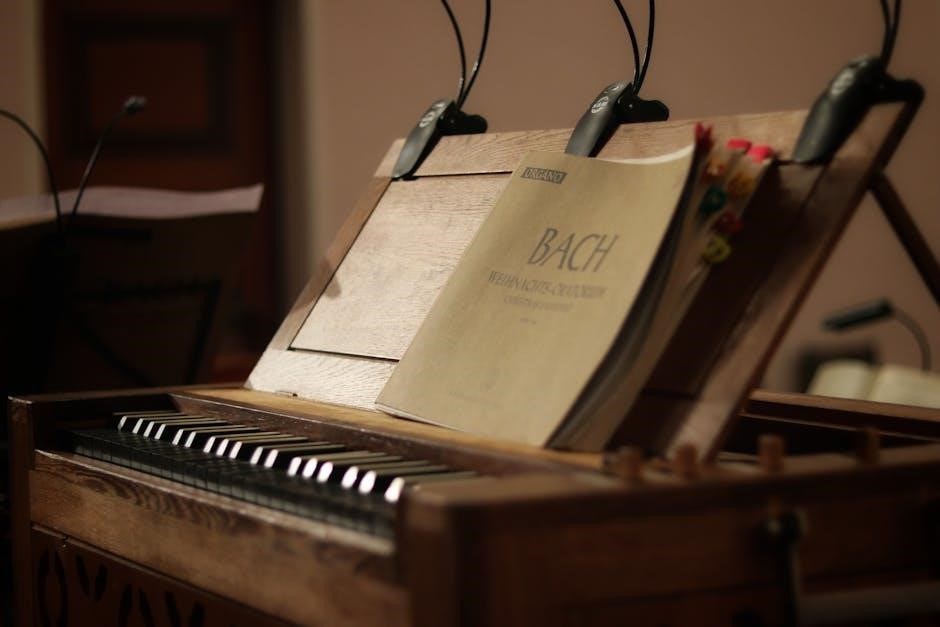
piano book pdf beginners
Piano Book PDF for Beginners: An Introductory Guide
Embark on your musical journey with our introductory guide to piano books in PDF format! This resource is tailored for absolute beginners, assuming no prior musical knowledge. We’ll explore how these books unlock the mystery of the piano keyboard with simple and effective methods.
Understanding the Piano Keyboard
The piano keyboard consists of white and black keys, arranged in a specific pattern. The black keys are grouped in sets of two and three, providing a visual landmark for navigating the keyboard. These groups help us to quickly locate and identify the notes we are looking for. The keys on the left side of the keyboard produce lower-pitched notes, typically played with the left hand, while the keys on the right side produce higher-pitched notes, usually played with the right hand.
The layout of the piano keyboard is based on the chromatic scale, which includes all the notes in Western music. The white keys represent the natural notes (A, B, C, D, E, F, and G), while the black keys represent sharps and flats. Understanding this arrangement is fundamental to learning to play the piano.
Many beginner piano books offer visual aids and diagrams to help students memorize the positions of the notes on the keyboard. Some books also use mnemonics or other memory tricks to make learning easier; With practice and repetition, beginners can quickly become familiar with the layout of the piano keyboard and start playing simple melodies and chords.
Exploring the keyboard is an essential first step in your piano journey!
Note Recognition for Beginners
A crucial step in learning to play the piano is mastering note recognition. This involves identifying the notes on the musical staff and associating them with their corresponding keys on the piano keyboard. Many beginner piano books utilize various techniques to simplify this process, such as finger-number and letter-name notations that lead to regular stave notation.
Visual aids, like characters associated with specific notes, can also make note learning more engaging and effective. Some books even incorporate writing activities and theory exercises to reinforce understanding.
Effective note recognition relies on understanding the layout of the grand staff, which consists of two staves: the treble clef for the right hand and the bass clef for the left hand. Each line and space on the staff corresponds to a specific note. Learning to quickly identify these notes is essential for reading music and playing melodies.
Practice and repetition are key to developing fluency in note recognition. Beginner piano books often include exercises that focus on identifying notes in different positions on the staff and associating them with the correct keys on the keyboard.
Start your journey to fluent note reading today!
Basic Piano Chords for Beginners
Understanding basic piano chords is fundamental to playing a wide range of music. Chords are combinations of notes played simultaneously, creating harmonic foundations for melodies. For beginners, mastering a few essential chords unlocks the ability to play countless songs.
The most common basic chords are major and minor triads. A triad consists of three notes: the root, the third, and the fifth of a scale. For example, a C major chord consists of the notes C, E, and G. A C minor chord consists of the notes C, Eb, and G.
Many beginner piano books offer simplified chord charts and diagrams to help students learn the finger positions for each chord. These charts often include visual representations of the keyboard and the corresponding finger placements.
Learning to transition smoothly between chords is also crucial. Practice exercises that focus on chord progressions can help develop finger dexterity and coordination. Start with simple progressions like C-G-Am-F and gradually introduce more complex sequences.
Don’t be afraid to experiment and explore different chord combinations. With practice and dedication, you’ll be able to accompany melodies and create your own musical arrangements. Free resources such as downloadable chord charts are available to aid you.
Reading Music Basics for Piano
Learning to read music is an essential skill for any aspiring pianist. While it may seem daunting at first, breaking it down into manageable steps makes the process much easier. Start by familiarizing yourself with the staff, which consists of five lines and four spaces. Each line and space represents a different musical pitch.
The treble clef, also known as the G clef, is used for higher-pitched notes typically played by the right hand. The bass clef, or F clef, is used for lower-pitched notes usually played by the left hand. Understanding the notes associated with each line and space on both clefs is crucial.
Note values indicate the duration of each note. Common note values include whole notes, half notes, quarter notes, and eighth notes. Rests represent silence and also have different durations.

Time signatures indicate the number of beats in each measure and the type of note that receives one beat. For example, a 4/4 time signature means there are four beats in each measure, and a quarter note receives one beat.
Practice reading simple melodies and rhythms regularly. Many beginner piano books include exercises specifically designed to develop your music reading skills. With consistent effort, you’ll be able to sight-read music with confidence.

Free Piano Lessons PDF Resources
For aspiring pianists on a budget, numerous free PDF resources offer a fantastic starting point. These resources cater to various learning styles and skill levels, providing accessible pathways to musical education. Many websites and organizations offer comprehensive piano lesson PDFs that cover everything from basic music theory to simple melodies.
Look for resources that include clear explanations of musical concepts, diagrams of the piano keyboard, and exercises to reinforce your understanding. Some PDFs focus on specific areas, such as chord progressions or sight-reading, allowing you to tailor your learning to your interests.
Several websites offer free sheet music for beginner piano players. These arrangements often feature simplified versions of popular songs, making it easier to learn and enjoy playing. Be sure to check the licensing terms of any PDF you download to ensure you’re using it legally.
Online communities and forums dedicated to piano learning can be excellent sources of free PDF resources. Members often share their own lesson plans, exercises, and arrangements, providing a wealth of material to explore.

Remember to supplement these free resources with consistent practice and, if possible, guidance from a qualified piano teacher.
Easy Piano Songs for Beginners (PDF Sheet Music)
One of the most rewarding aspects of learning piano is playing your favorite songs! Thankfully, a plethora of easy piano songs are available as PDF sheet music, perfect for beginners eager to apply their newfound skills. These simplified arrangements typically feature large, easy-to-read notes and minimal hand movements, allowing you to focus on accuracy and rhythm.
Many popular nursery rhymes and folk songs are excellent choices for beginner piano students. These melodies are often simple and repetitive, making them easy to memorize and play. Look for arrangements that include finger numbers to guide your hand placement.
Numerous websites and online sheet music stores offer a wide selection of easy piano songs in PDF format. Some of these resources are free, while others require a small fee. Be sure to choose arrangements that are appropriate for your skill level.
Consider starting with songs that use only a few chords, such as C, G, F, and Am. These chords are fundamental to many popular songs, and mastering them will open up a vast repertoire of possibilities.
As you progress, gradually increase the difficulty of the songs you choose. This will help you develop your technique and expand your musical horizons. Remember to have fun and enjoy the process of learning!
Piano Learning Apps and Software
In today’s digital age, piano learning apps and software have revolutionized how beginners approach the instrument. These interactive tools offer a dynamic and engaging learning experience, supplementing traditional piano books and lessons.
Many apps feature interactive keyboards that allow you to play along with lessons and exercises. Some even provide real-time feedback on your accuracy and timing. Gamified elements, such as points, badges, and leaderboards, can make learning more fun and motivating.
Software programs often offer comprehensive courses that cover everything from basic music theory to advanced playing techniques. These programs may include video tutorials, sheet music, and practice exercises. Some even allow you to record yourself playing and receive feedback from instructors.
When choosing a piano learning app or software, consider your learning style and goals. Some apps are designed for beginners, while others cater to more advanced players. Look for features such as personalized learning plans, progress tracking, and a wide selection of songs.
Popular options include flowkey, Simply Piano, and Skoove. These apps offer a variety of features and subscription options to suit different needs and budgets. Experiment with free trials to find the app or software that’s right for you.
Choosing Your First Piano/Keyboard
Selecting your first piano or keyboard is a crucial step in your musical journey. With numerous options available, it’s essential to consider your needs, budget, and learning goals. This section guides beginners through the process, ensuring they make an informed decision.
Acoustic pianos offer a traditional playing experience with rich sound and responsive keys. However, they can be expensive and require regular tuning. Digital pianos provide a more affordable and practical alternative, with features like adjustable volume, headphone jacks, and a variety of instrument sounds.
Keyboards are generally more portable and budget-friendly than digital pianos. They often have fewer keys and may not offer the same level of touch sensitivity. However, they can be a great option for beginners who are just starting out.
Consider the number of keys. Full-size pianos have 88 keys, while keyboards may have fewer. For serious piano study, 88 keys are recommended. Touch sensitivity, or the ability to respond to the force of your touch, is also important. Weighted keys simulate the feel of an acoustic piano.
Research brands, read reviews, and, if possible, try out different models before making a purchase. Look for reputable retailers and consider buying used instruments to save money. Enjoy the process of finding the perfect instrument to start your musical adventure!
Finger Exercises and Techniques
Developing proper finger exercises and techniques is paramount for any aspiring pianist. These exercises build finger strength, dexterity, and coordination, laying the foundation for more advanced playing.
Start with basic scales and arpeggios. These exercises help familiarize you with the keyboard and develop evenness in your playing. Practice scales in different keys and tempos, gradually increasing speed and accuracy.
Hanon exercises are a classic resource for developing finger strength and independence. These exercises focus on repetitive patterns that isolate and strengthen individual fingers. Czerny exercises offer a more musical approach to technical development, incorporating melodies and harmonies.
Pay attention to your posture and hand position. Sit upright with your feet flat on the floor or on a footrest. Keep your wrists relaxed and your fingers curved. Avoid tension in your shoulders and arms.
Practice regularly, even if it’s just for a few minutes each day. Consistency is key to developing good technique. Listen to recordings of professional pianists and try to emulate their sound and phrasing.

Work with a qualified piano teacher who can provide personalized guidance and feedback. A teacher can help you identify and correct bad habits before they become ingrained. With dedication and practice, you can develop the finger strength and technique necessary to play the piano with confidence and artistry.